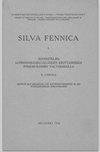利用Sentinel-2数据辅助估算杨树人工林木材产量的大尺度两阶段估算
IF 1.7
3区 农林科学
Q2 FORESTRY
引用次数: 12
摘要
对木材产品日益增长的需求,加上保护天然林的努力,支持了全球人工林面积的稳步增长。本文提出了一种两阶段采样策略,用于农业用地速生林木作物总面积和总材积的大规模评估。第一阶段是在高分辨率遥感图像上使用镶嵌分层抽样进行的,这足以通过蒙特卡罗积分估计器估计种植园总面积。第二阶段是对第一阶段选择的人工林进行分层抽样,目的是通过第一阶段Horvitz-Thompson估计器的近似值来估计总木材量。利用Sentinel-2植被指数作为线性回归估计器的辅助信息,提高了基于单一样本数据的估计器的设计精度。给出了总估计量和总估计量的基于设计的方差。在杨树人工林的几种人工分布(随机分布、聚类分布和空间趋势分布)下,为了检验这两种可选估计器基于设计的性能,进行了模拟研究。据报道,意大利北部也有一项申请。事实证明,回归估计器总是比基于单一样本信息的估计器更好。讨论了在第一阶段将所建议的抽样方案与采用镶嵌分层抽样的传统国家森林清查相结合的可能性。本文章由计算机程序翻译,如有差异,请以英文原文为准。
Large-scale two-phase estimation of wood production by poplar plantations exploiting Sentinel-2 data as auxiliary information
Growing demand for wood products, combined with efforts to conserve natural forests, have supported a steady increase in the global extent of planted forests. Here, a two-phase sampling strategy for large-scale assessment of the total area and the total wood volume of fast-growing forest tree crops within agricultural land is presented. The first phase is performed using tessellation stratified sampling on high-resolution remotely sensed imagery and is sufficient for estimating the total area of plantations by means of a Monte Carlo integration estimator. The second phase is performed using stratified sampling of the plantations selected in the first phase and is aimed at estimating total wood volume by means of an approximation of the first-phase Horvitz-Thompson estimator. Vegetation indices from Sentinel-2 are exploited as freely available auxiliary information in a linear regression estimator to improve the design-based precision of the estimator based on the sole sample data. Estimators of the totals and of the design-based variances of total estimators are presented. A simulation study is developed in order to check the design-based performance of the two alternative estimators under several artificial distributions supposed for poplar plantations (random, clustered, spatially trended). An application in Northern Italy is also reported. The regression estimator turns out to be invariably better than that based on the sole sample information. Possible integrations of the proposed sampling scheme with conventional national forest inventories adopting tessellation stratified sampling in the first phase are discussed.
求助全文
通过发布文献求助,成功后即可免费获取论文全文。
去求助
来源期刊

Silva Fennica
农林科学-林学
CiteScore
3.50
自引率
11.10%
发文量
21
审稿时长
3 months
期刊介绍:
Silva Fennica publishes significant new knowledge on forest sciences. The scope covers research on forestry and forest ecosystems. Silva Fennica aims to increase understanding on forest ecosystems, and sustainable use and conservation of forest resources. Use of forest resources includes all aspects of forestry containing biomass-based and non-timber products, economic and social factors etc.
 求助内容:
求助内容: 应助结果提醒方式:
应助结果提醒方式:


